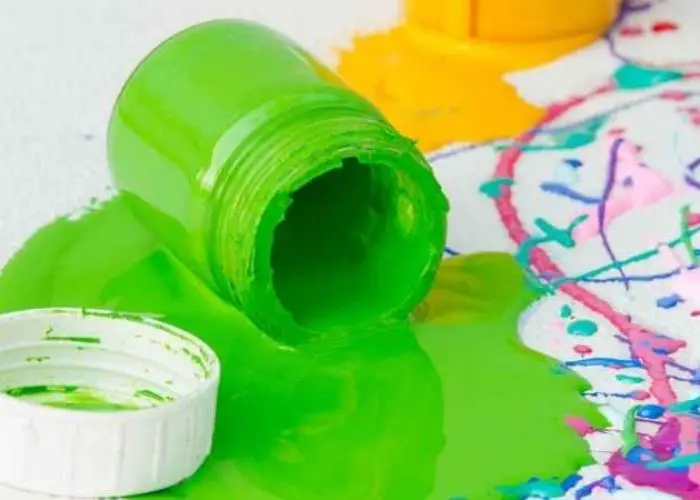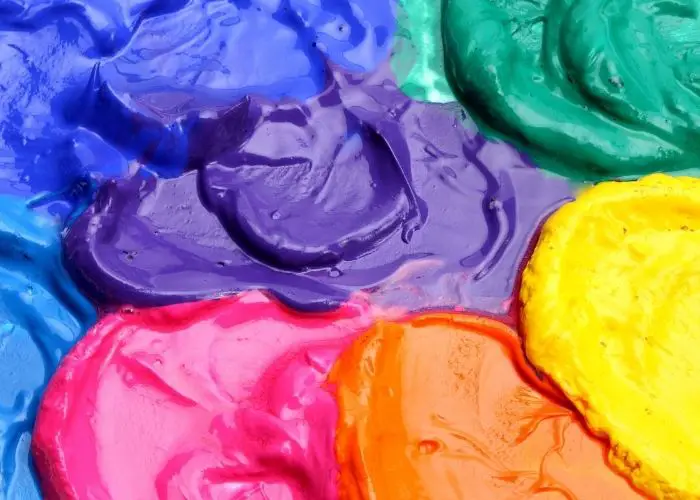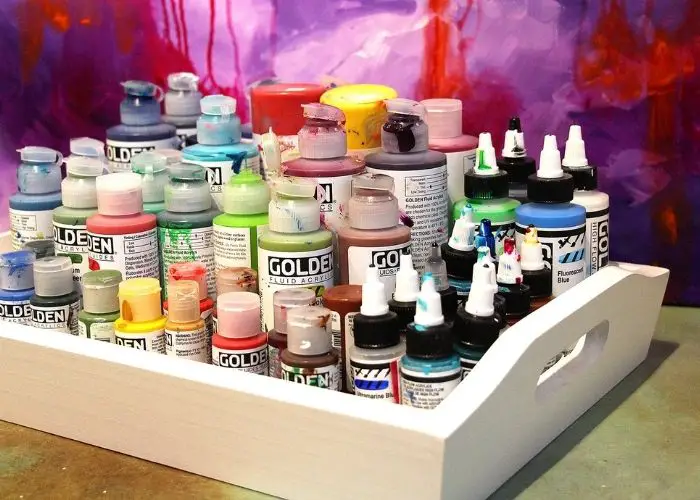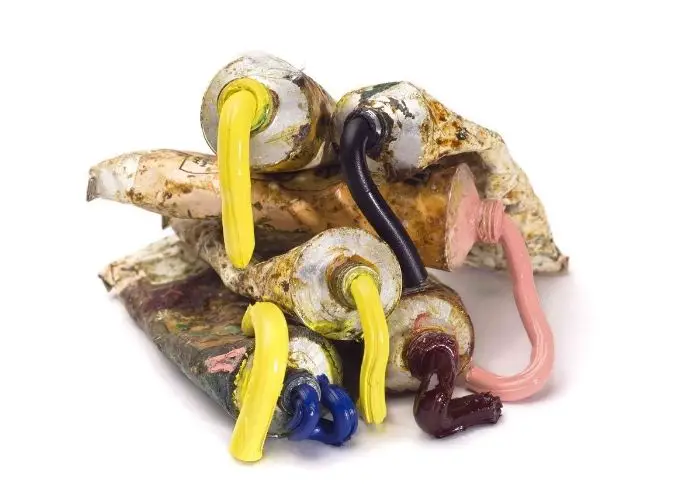Whether you’re a beginner artist just starting out, or a seasoned pro, at some point, you’ve probably asked yourself: does acrylic paint expire?
In this blog post, we’ll answer that question and more! We’ll talk about what happens to acrylic paints over time, how to store your paints to make them last longer, and whether there are any signs that your paint has gone bad.
Whether you’re unsure if that old tube of white paint is still usable or whether it’s time to toss out an unused tube of black, keep reading for all the information.
Does Acrylic Paint Expire?
Yes, eventually, all paints do expire. Acrylic paint is no exception. The lifespan of acrylic paint depends on a few factors, including how it’s stored and the quality of the paint to begin with. Generally speaking, you can expect acrylic paint to last two to five years. However, if it’s well-cared for, it can last much longer than that.
Just like any other product, paint does have an expiration date. However, manufacturers have no legal requirement to print an expiration date on paint tubes or cans, unlike food or medicine.
So how can you tell if your paint is still good to use? There are a few things to look for:
- The physical appearance of the paint. If it has changed colors or thickened, it’s probably time to throw it out.
- How the paint performs. If it doesn’t go on smoothly or dries unevenly, both are signs that it’s time for new paint. If you’re still not sure, try doing a test patch.
- The smell of the paint. If it smells bad, that’s a sign that it’s gone bad, and you should not use it.
- The texture of the paint. If it has become lumpy or hard, it’s no longer usable.
If you’re unsure whether your paint is still good, it’s always best to err on caution and just buy new paint at any art supplies.
It’s not worth risking your health or damaging your artwork by using expired paint.
Will Acrylic Paint Expire at Some Point?

Technically, acrylic paint is made of synthetic material and does not “expire” in the traditional sense of the word.
However, over time it will deteriorate and lose its original properties. But there are a few ways which we’ll discuss below that you can try and extend the lifespan of your paint.
How to Extend the Lifespan of Your Paint
To extend the lifespan of your paint, it’s important to store it properly. Here are a few tips:
- Store your paint in a cool, dry place. Extreme temperatures can cause the paint to change consistency and color.
- Keep your paint tubes or bottles tightly sealed when not in use. This will prevent the paint from drying out.
- If possible, store your paint in airtight containers. This will further prevent the paint from drying out and going bad.
- Avoid exposing your paint to sunlight. Ultraviolet light can damage the pigments in the paint and cause them to fade.
- If you have a leftover paint you want to keep, transfer it to a small container, so there is less air exposure.
- In the case of a damaged paint container, find an airtight household object you can pour the paint into for safe storage.
Why Does Acrylic Paint Go Bad?
Acrylic paints are made of synthetic materials that are not susceptible to mold or spoilage. However, the pigments in the paint can degrade and change color over time.
The paint can also become thicker and less viscous. These changes are due to a variety of factors, including exposure to light, air, and extreme temperatures or excess moisture.
Exposure to light and air
These are the most common causes of paint degradation. The pigments in the paint can break down when exposed to ultraviolet light, and the paint will dry out and become hard when exposed to air.
Extreme temperatures
Extreme cold will cause the paint to become brittle, while extreme heat will cause it to become runny.
Mold and mildew
Mold and mildew can grow on paint if it is stored in a damp environment. However, these are not common problems with acrylic paints because they do not contain organic materials that aid in mold growth.
All of these factors can contribute to the paint changing color, consistency, and performance over time. However, if you store your paint properly and use it within a few years, it should be usable.
How Long Does Acrylic Paint Last Once Opened?
Once opened, an acrylic paint tube or bottle has a shelf life of about two to four years. But, again, this depends on how the paint is stored and the quality of the paint to begin with.
If you take good care of your paint, it can last even longer! The common issues are usually drying out, getting hard, or changing color.
Signs that Your Paint has Gone Bad
Here are a few signs that your paint has gone bad:
- The physical appearance of the paint has changed.
- The paint does not go on smoothly or dries unevenly.
- The texture of the paint has changed.
- The paint does not perform the same as when it was new. It may be dry, clumpy, or have an uneven texture.
- The paint has a sour smell
- The paint has become hard or lumpy.
Can You Use Expired Acrylic Paint?
It’s not recommended to use expired paint, as it may be harmful to your health. However, if you’re desperate, you can try thinning the paint with tap water or mixing it with another color.
But keep in mind that the results will probably not be what you’re hoping for! You should consider two factors if you want to use expired acrylic paint: temperature exposure and dry time.
Temperature exposure is important because it changes the chemical makeup of the paint. If you store your paint in a hot environment, it will cause the paint to dry out and become brittle.
The same is true for cold temperatures. However, if you store your paint in a cool, dry place, it will last longer.
Dry time is also an important factor to consider. Acrylic paints dry quickly, so they may have already started to dry out if it’s been open for a while.
Dried paint won’t be easy to work with, resulting in less satisfaction.
How Do You Fix or Improve Old Acrylic Paint?
There are a few ways how to reactivate old acrylic paint:
- First, add a solvent such as water, acetone, or alcohol to thin the paint.
- Next, mix the paint with another color to change the color.
- Third, add a retarder to slow down the drying time.
- If the paint is too dry, you can rehydrate the dry paint with a wet paint brush.
- Use a medium to change the consistency of the paint.
But keep in mind that the results will probably not be what you’re hoping for.
How to Fix Lumpy Acrylic Paint

Lumpy acrylic paint is a common problem for artists. The good news is that it’s easy to fix. All you need is some water, a brush, and a little bit of patience.
The first step is to add a few drops amount of water to the paint. You don’t need to add much – just enough to make it liquid again. Then, use a brush to mix the paint until it’s smooth.
If the paint is still lumpy or feels streaky, add a little more water and mix it again. Keep doing this until the paint is smooth and free of any lumps.
(You can learn more in our guide on how to make acrylic paint none streaky if the situation persists).
How Do You Store Acrylic Paint?
The best way to store acrylic paint is in a cool, dry place. Extreme temperatures can cause the paint to change consistency and color.
You should also keep your paint tubes or bottles tightly sealed when not in use. This will prevent the paint from drying out. If possible, store your paint in an airtight container.
This will further prevent the paint from drying out and going bad. Avoid exposing your paint to sunlight. Ultraviolet light can damage the pigments in the paint and cause them to fade.
If you’re not using all of a particular color, transfer it to a smaller paint container, so there is less air exposure. This will help keep the paint from drying out and going bad, as well as increase its shelf life.
Learn more on How To Store Acrylic Paint Safely.
How to Rehydrate Acrylic Paint
If your paint has become too thick or dry, you can do a few things to rehydrate it. One is to add a small amount of water and mix it well using a palette knife.
Another is to add a medium such as Liquitex Flow-Aid Fluid Additive or Golden Open Acrylic Flow Release.
You can also try using a humidifier in the room where you keep your paint. These methods should help restore dried paint to its original consistency.
Best Places to Store Acrylic Paint

The best places to store acrylic paint are cool, dry places away from direct sunlight. A basement or closet is a good option. You can also purchase airtight containers to store your paint in.
Best Temperature to Store Acrylic Paint
Acrylic paint, being water-based, is prone to freezing, which can significantly impact its consistency and performance.
Therefore, storing acrylic paint within specific temperature ranges is crucial to preserve its quality.
To address the question of whether acrylic paint freezes, the answer is yes. When exposed to freezing temperatures, acrylic paint can solidify and become unusable.
To ensure optimal storage conditions, keep acrylic paint above freezing but below 90 degrees Fahrenheit. This helps prevent the paint from freezing while avoiding excessive heat, which can make the paint excessively runny and affect its application.
So, remember to store your acrylic paint within a temperature range of 50 to 70 degrees Fahrenheit to protect its integrity and maintain its desired consistency.
How to Prolong Acrylic Paint Dry Time
There are a few ways to prolong the dry time of acrylic paint:
- First, add a retarder to the paint.
- Then, store the paint in a cool, dry place.
- Next, keep the paint sealed when not in use.
- Finally, avoid exposing the paint to sunlight.
What to Do With Old Paint
If you have old paint that you’re not going to use, the best thing to do is donate it to a local school or community center. They may be able to use it for an art project.
You can also try selling it online. Many people are looking for cheap or free paint for their projects. Finally, you can dispose of it properly.
Check with your local waste management center to see what their guidelines are. Paint disposal should not be taken lightly.
Paint contains harmful chemicals that can be detrimental to the environment if not disposed of properly. Therefore, it’s important to follow the proper procedures for disposing of old paint.
Read more: Can You Sand Acrylic Paint?
FAQs
Can I use expired acrylic paint?
It’s not advised to utilize old paint since it may be harmful to your health. However, if you’re desperate, you can try thinning the paint with water or combining it with another hue. However, keep in mind that the outcomes will most likely not live up to your expectations.
Can I store acrylic paint in a refrigerator?
Yes, acrylic paint can be kept in the refrigerator. However, before utilizing it, make sure the paint is at room temperature. Otherwise, the paint will be too hard and not stick to your surface.
How long do acrylic paints last?
The shelf life of acrylic paints is between 3-5 years. Make sure to keep them in a cool, dry place away from sunlight. You should also keep the paint tubes or bottles tightly sealed when not in use. This will help prevent the paint from drying out and going bad.
What happens if you use expired paint?
If you use expired paint, the color may be off, and the consistency may differ. The paint may also not adhere to your surface as well. Therefore, it’s not advised to use old paint since it may be harmful to your health. However, if you’re in a bind, you may thin the paint with water or mix it with another color and binder together with a palette knife.
How do you know if acrylic paint is bad?
If the paint has changed colors or has a bad odor, it’s probably bad. You should also check the expiration date on the paint. If it’s expired, it’s probably not going to be good. Finally, it’s probably bad if the paint is lumpy or has a different consistency.
Is acrylic paint permanent?
Yes, acrylic paint is generally considered permanent. It forms a durable, water-resistant layer once it dries. However, the permanence of acrylic can vary depending on the quality of the paint and the conditions it is exposed to. High-quality acrylic paints and proper storage can ensure long-lasting results, but some fading or color shift may occur over time.
Conclusion
So, does acrylic paint expire? Yes, acrylic paint does expire, but it can last for a long time if it’s stored properly. Make sure to keep your paint in a cool, dry place away from sunlight.
You should also keep the paint tubes or bottles tightly sealed when not in use. This will help prevent the paint from drying out and going bad.
If you have old paint that you’re not going to use, the ideal thing to do is donate it to a local school or community center. They may be able to use it for an art project.
Thanks for reading! We hope this article was helpful. Have any questions or comments? Leave them below! We’re happy to help.










Leave a Reply